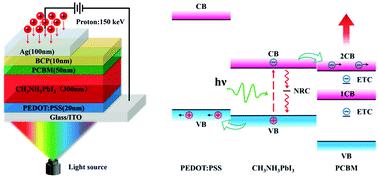当前位置:
X-MOL 学术
›
J. Mater. Chem. C
›
论文详情
Our official English website, www.x-mol.net, welcomes your feedback! (Note: you will need to create a separate account there.)
Radiation hardness and abnormal photoresponse dynamics of the CH3NH3PbI3 perovskite photodetector
Journal of Materials Chemistry C ( IF 6.4 ) Pub Date : 2020-12-19 , DOI: 10.1039/d0tc05148a Guodong Xiong 1, 2, 3, 4, 5 , Zilun Qin 6, 7, 8, 9, 10 , Bo Li 1, 2, 3, 4, 5 , Lei Wang 1, 2, 3, 4, 5 , Xuewen Zhang 1, 2, 3, 4, 5 , Zhongshan Zheng 1, 2, 3, 4, 5 , Huiping Zhu 1, 2, 3, 4, 5 , Suling Zhao 6, 7, 8, 9, 10 , Jiantou Gao 1, 2, 3, 4, 5 , Binhong Li 1, 2, 3, 4, 5 , Jianqun Yang 5, 11, 12, 13 , Xingji Li 5, 11, 12, 13 , Jiajun Luo 1, 2, 3, 4, 5 , Zhengsheng Han 1, 2, 3, 4, 5 , Xinyu Liu 1, 2, 3, 4, 5 , Fazhan Zhao 1, 2, 3, 4, 5
Journal of Materials Chemistry C ( IF 6.4 ) Pub Date : 2020-12-19 , DOI: 10.1039/d0tc05148a Guodong Xiong 1, 2, 3, 4, 5 , Zilun Qin 6, 7, 8, 9, 10 , Bo Li 1, 2, 3, 4, 5 , Lei Wang 1, 2, 3, 4, 5 , Xuewen Zhang 1, 2, 3, 4, 5 , Zhongshan Zheng 1, 2, 3, 4, 5 , Huiping Zhu 1, 2, 3, 4, 5 , Suling Zhao 6, 7, 8, 9, 10 , Jiantou Gao 1, 2, 3, 4, 5 , Binhong Li 1, 2, 3, 4, 5 , Jianqun Yang 5, 11, 12, 13 , Xingji Li 5, 11, 12, 13 , Jiajun Luo 1, 2, 3, 4, 5 , Zhengsheng Han 1, 2, 3, 4, 5 , Xinyu Liu 1, 2, 3, 4, 5 , Fazhan Zhao 1, 2, 3, 4, 5
Affiliation

|
The effects of proton irradiation on the electrical and optical properties of hybrid perovskite photodetectors have been investigated in this paper. Our results reveal that no significant changes in the photoelectric properties of the perovskite photodetectors are observed when the proton fluence accumulates to 1 × 1012 p cm−2. However, with further increase of proton fluence, the photoelectric conversion efficiency of the perovskite photodetectors begins to decrease notably. This can be attributed to the introduction of deep defect levels within the bandgaps of the CH3NH3PbI3 active layer and the phenyl-C61-butyric acid methyl ester (PCBM) layer after proton irradiation. Based on time-resolved photoluminescence measurements, the deep defect levels in the active layer behave as nonradiative recombination centers, resulting in a reduction of carrier lifetime. According to our first-principles calculations, the deep defect levels in the PCBM layer act as electron trap centers, leading to an accumulation of photo-generated electrons. Most interestingly, when the proton fluence reaches 1 × 1014 p cm−2, a transient inverse current in the perovskite photodetectors is observed after stopping illumination. This abnormal phenomenon is due to the accumulation and release of electrons trapped in the PCBM layer, which can diffuse to the perovskite active layer and form the inverse current.
中文翻译:

CH3NH3PbI3钙钛矿光电探测器的辐射硬度和异常光响应动力学
本文研究了质子辐照对混合钙钛矿光电探测器电学和光学性能的影响。我们的结果表明,当质子注量累积到1×10 12 p cm -2时,钙钛矿光电探测器的光电性能没有明显变化。然而,随着质子通量的进一步增加,钙钛矿光电检测器的光电转换效率开始显着降低。这可以归因于在CH 3 NH 3 PbI 3的带隙内引入了深缺陷水平。活性层和质子辐照后的苯基-C61-丁酸甲酯(PCBM)层。基于时间分辨的光致发光测量,有源层中的深缺陷水平表现为非辐射复合中心,从而缩短了载流子寿命。根据我们的第一性原理计算,PCBM层中的深缺陷水平充当电子陷阱中心,导致光生电子的积累。最有趣的是,当质子注量达到1×10 14 p cm -2时,在停止照明后,在钙钛矿光电探测器中观察到瞬态反向电流。这种异常现象是由于捕获在PCBM层中的电子的积累和释放,这些电子可以扩散到钙钛矿活性层并形成反向电流。
更新日期:2021-01-19
中文翻译:

CH3NH3PbI3钙钛矿光电探测器的辐射硬度和异常光响应动力学
本文研究了质子辐照对混合钙钛矿光电探测器电学和光学性能的影响。我们的结果表明,当质子注量累积到1×10 12 p cm -2时,钙钛矿光电探测器的光电性能没有明显变化。然而,随着质子通量的进一步增加,钙钛矿光电检测器的光电转换效率开始显着降低。这可以归因于在CH 3 NH 3 PbI 3的带隙内引入了深缺陷水平。活性层和质子辐照后的苯基-C61-丁酸甲酯(PCBM)层。基于时间分辨的光致发光测量,有源层中的深缺陷水平表现为非辐射复合中心,从而缩短了载流子寿命。根据我们的第一性原理计算,PCBM层中的深缺陷水平充当电子陷阱中心,导致光生电子的积累。最有趣的是,当质子注量达到1×10 14 p cm -2时,在停止照明后,在钙钛矿光电探测器中观察到瞬态反向电流。这种异常现象是由于捕获在PCBM层中的电子的积累和释放,这些电子可以扩散到钙钛矿活性层并形成反向电流。



























 京公网安备 11010802027423号
京公网安备 11010802027423号